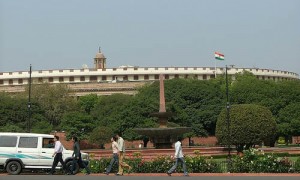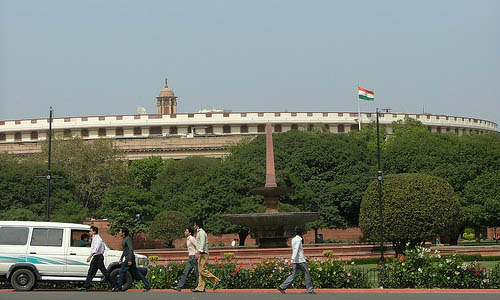By: Ravi Sinha
 Track2Realty Exclusive: Stable government has been the buzz word in India for quite some time; it has actually been one of the focal points of General Elections of 2014. In India since 1984 no government at centre could take charge of the office without the added baggage of unlike minded friends as alliance partners.
Track2Realty Exclusive: Stable government has been the buzz word in India for quite some time; it has actually been one of the focal points of General Elections of 2014. In India since 1984 no government at centre could take charge of the office without the added baggage of unlike minded friends as alliance partners.
The rise and growth of regional aspirations and emergence of regional power centres, however, has always been blamed in the academic circles as bad economics and governance since pulls and pressures of conflicting interests had brought the governance at standstill on many occasions. Just at a time when the country seemed to be destined to policy paralysis, the electoral verdict of 2014 has changed the dynamics of governance altogether.
A clear and decisive mandate to the NDA Government at centre clearly suggests that the days of coalition compulsions are over. While the political pundits are deliberating over the cost-benefit analysis of too powerful a government with toothless opposition and weakening regional forces, India’s business community has finally got what it has been looking for: a stable government with business friendly face as the Prime Minister of India. However, with the obvious sky high expectations the challenges for the new government at office is not that easy. And it is not just the business captains of the country; rather even the young first-time voters who turned out in record numbers to cast votes are equally restless to see the tangible results too soon.
What can the government do to make sure the perception of policy paralysis changes? Of course, the only answer to this is the measures that the new government can take to revive the economy. Once the economy is on a growth curve, many other pending issues will naturally be on the back seat with collective consciousness backing the growth story of the country. Hence, the new government has some real challenges to deal with beyond the euphoria of a stable government at the helm of affairs.
A turnaround of the economic wheel is, however, not easy as the current account deficit clearly suggests there is no room for any largesse on part of the government; rather subsidies and other beneficiary measures have to be curbed in the short term. What affects the most to the average Indians, interest rate, can also not be cut till the time inflation is not curbed. It is a catch 22 of Indian economy and a balancing act is something that will be the first acid test of the government.
So, the first task that is cut out for the Narendra Modi Government is to control the inflation that has been the prime reason why they have been given the mandate. This can be quite a challenge, if the forthcoming Monsoon does not play as sportingly as the voters for the Modi Government. After all, India’s economy is still dictated by the monsoon fortunes. Naina Lal Kidwai, CEO, HSBC India has a suggestion for the government when she says, “The government should, on a priority basis, restart the investment cycle. It should free the land, labour and capital markets from their rigidities; make fiscal prudence the cornerstone of its functioning; evolve a plan for mitigating food inflation. On the social side, it should look at areas like health, environment and education.”
However, framing a roadmap for fiscal consolidation is easier said than done; it has its own challenges. The government will have no option but to constantly increase the fuel prices to completely eliminate subsidy and that is something which may not go down well with the voters who have high expectation of government’s largesse. Use of direct transfer of cash for subsidies is one of the many measures to help check the public anger, but then such attempts in the past have been met with quite resistance by various sections, including the party that is now in power. Deepak Parekh, Chairman, HDFC has a word of caution in his wish list when he says, “The economic agenda is huge. What is needed is simplification. In the World Bank ranking on ease of doing business we are right at the bottom. I think the name of the game should be to make it simpler for people to invest.”
Though the government seems to be determined to improve business environment by easing laws and policies, it is not something that can be achieved in a short span of time. As a matter of fact, a long term strategy is needed to see tangible results after easing the FDI norms and time-bound clearances of projects. After all, a poor business environment has deterred the investment in India, of late, which is the biggest reason of decline in growth. Add to it, corruption and leakage in the system at every level and the new government has a challenge in hand to deal with.
There is no denying that long-pending reforms such as GST and DTC need to be implemented at the earliest. There is also a need to expedite the liberalisation of FDI regime. The India Inc is by and large optimistic that with a strong mandate, the new government will do well and will implement economic policies that benefit people and industry.
Rahul Gaur, CMD of Brys Group has a caveat here when he urges the new government to ease credit flow to industry and infrastructure. According to him, at a time when the government does not have financial surplus and the nation is struggling to manage with the shortages, the core focus should be to identify the execution capability to execute the large infra projects. For that the government should better create an atmosphere where private players have access to long term funds.
“The policies of the government have to be clear on the lending norms and the government should target steps to boost lending to infrastructure sector. Housing and infrastructure can revitalise the economy, create more jobs and bring overall change in the outlook to the economy. I do understand the reluctance of banks to fund infrastructure due to asset liability mismatch but then better infrastructure is the only way to help the country grow at above 8% GDP. I feel the time has come for the government to roll out clearly defined measures for ease of credit flow,” says Gaur.
Analysts have often pointed out that one of the key areas where India could have reaped its demographic dividend is the manufacturing sector; something that China has already done in the last over two decades. The new government must take pro-active steps to encourage local manufacturing and for that it should give fast track clearances to stalled manufacturing projects; re-look the SEZ policy which have thus far proved to be detrimental and also the government can put the Delhi-Mumbai Industrial Corridor on a fast forward execution.
Many economists believe instead of pro-poor policies like NAREGA, streamlining the manufacturing is a better way to bring the poor into economic mainstream and also lessen India’s dependence on the agriculture. However, all these measures may sound to be very easily achievable, yet it needs time and concerted efforts to achieve. That could not be achieved in the last few years due to the compulsions of coalition politics. The challenge of governance is no doubt beyond the euphoria of a stable government.





